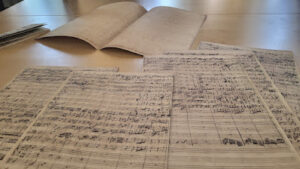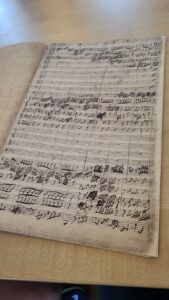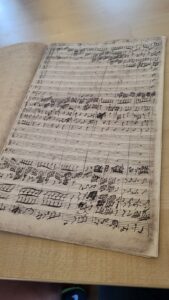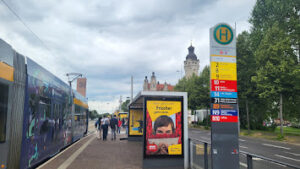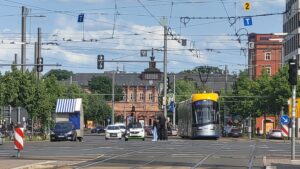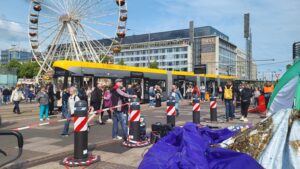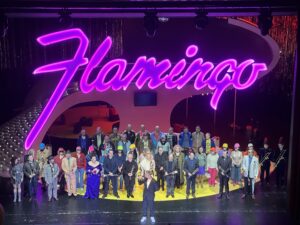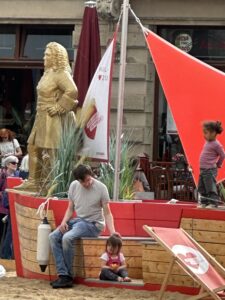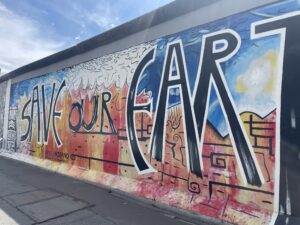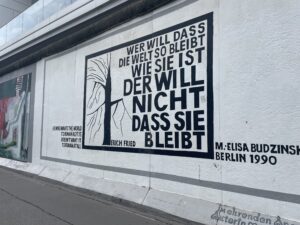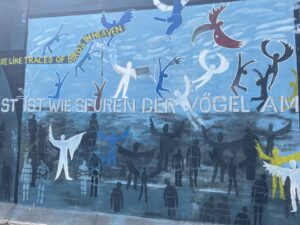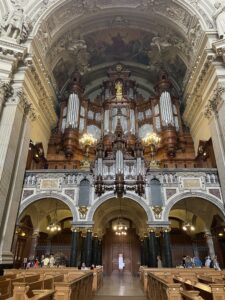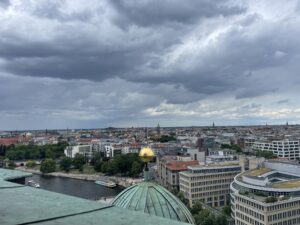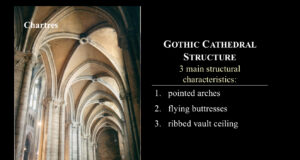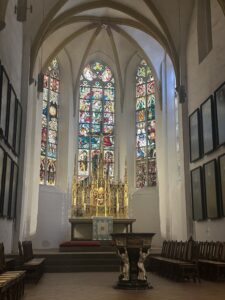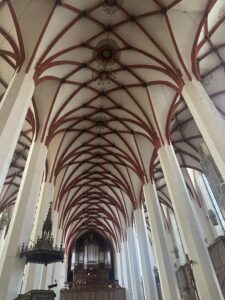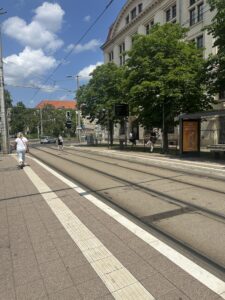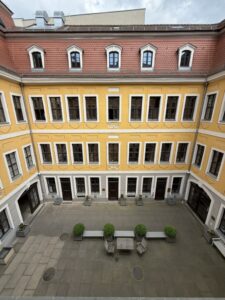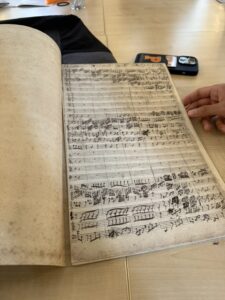

On Saturday night, a group of us went and saw Tchaikovsky’s Pique Dame (The Queen of Spades) at Oper Leipzig. The opera house itself was very grand, with four separate coat checks on the entry floor! The outside of the building was light gold or buttery yellow, and the inside was warm-feeling with various shades of beige and gold intermixed.
I’m someone who likes to go into shows somewhat blind. With opera, I tend to only read the synopsis and maybe listen to a few of the main songs before seeing the work because usually a bit more context is necessary for foreign-language pieces (especially since this was my first Russian opera). Funnily enough, because of having read the Met’s synopsis, I almost felt more confused during the opera since the director made so many choices that differed from the original version. The Queen of Spades is based on a story by Alexander Pushkin, which follows a man named Hermann (an engineer in the Imperial Russian army) who watches the other officers gamble every night but never gambles himself. When Count Tomsky relays a story of his grandmother, the Countess, Hermann learns of her gambling success and how she used the secret of the three winning cards. He becomes obsessed with learning her secret. This comes into conflict with his love for Lisa, a woman he initially does not know the name of but whom he has fallen in love with, since she is the Countess’ granddaughter and engaged to Prince Yeletsky. The opera ends in tragedy as Hermann’s dual obsessions with his love for Lisa and the secret of the cards result in the death of the Countess, a broken engagement between Lisa and Prince Yeletsky, Lisa’s death by drowning, and eventually his own. Having been tricked by the ghost of the countess, who tells him his three lucky cards are the 3, 7, and ace, he bets ridiculous sums of money on them only to find that the final card is not the ace at all, but the queen of spades. Having lost everything in pursuit of this fortune, he shoots himself, believing that the queen of spades is an amalgamation of the Countess herself, taking her revenge.
Throughout Oper Leipzig’s production, there were several notable variations that threw me off, given my preexisting knowledge of the plot. Some changes I liked or was at least intrigued by, while others contrasted too sharply with the libretto. Other directorial choices I felt were over the top, simply done for shock value. I have many thoughts about this production, and now I will pretend to be a weathered opera critic, unabashedly sure of her opinions.
Beginning with the set, I enjoyed most of the set design and usage of space. The curtain rose to reveal a rocky, graveyard-esque terrain that I heard several others describe as appearing like the surface of the moon. For a darker opera, it set the tone well, and throughout the show was well-utilized to portray all types of spaces (different bedrooms, a gambling house, the streets of St. Petersburg, etc.) 30 or so minutes into the opera, it was revealed that the stage could rise, revealing a fully-furnished room underneath the ground. I did not like how the set was used in Act II – frankly, I really didn’t like much about Act II in general. It began with a scrim (a gauzy fabric draped over the main area of the stage) where an image of the underground set was projected. Partway into the Act, during one of the arias, the stage rose again and the room underneath was shown. Now, projected onto the scrim were the actions of Hermann sneaking into the Countess’ room. This effect was cool at first, but it went on for almost the entire act and the illusion was shattered as the physical actors weren’t in time with their holographs. It also wasn’t clear what purpose this doubling of the scene served at all. My favorite use of the set was in Act III, where the aboveground layer was converted into a gambling house and a square rim of lights was set above the scene. I felt like Act III was the strongest act in terms of set usage – there just wasn’t as much going on which was a relief since many choices were so left field, they became distracting and took away from the music.
In terms of costuming, I didn’t love how either Hermann or Lisa was portrayed. Hermann often looked ragged with a stained shirt and wild hair, and his unappealing portrayal through the show made me very unsure of how to consider the love story between him and Lisa – despite being the main tenor role his character was very unsympathetic. I understand that Hermann is considered half-hero and half-antihero, and I would have understood a production fully leaning into the antihero angle, but an antihero is still not a villain, and I felt like it wasn’t made clear enough how we as the audience were supposed to feel about Hermann who was almost fully portrayed as a villainous character throughout. Especially in contrast to Prince Yeletsky who sings of his love of Lisa and his hope to be more than just a husband to her, Hermann seemed especially revolting as he repeatedly ignores Lisa’s please to leave her room, threatening to kill himself. Lisa herself was very nicely clothed in a fur robe when she’s first introduced but then for the entire rest of the show is in this strange jeans and gauze slip combination that looked neither elegant nor practical. Funnily enough, the only time Hermann is dressed nicely is in Act III when he enters the casino wearing a tuxedo with his hair slicked back. Yet, this image is immediately juxtaposed by the libretto where the other men sing of how ill and ragged Hermann looks. It could have been an interesting decision to make the only time Hermann looks put together as what is supposed to be his most repulsive moment and have the audience wonder what else it was about his demeanor that looked so sick (perhaps he looks sick with obsession – a fair assumption to make since it is written into the score that the men are supposedly frightened of his mad, confident demeanor while he gambles), BUT given the sheer number of directorial choices that felt half-baked, I didn’t feel like this was done with well thought out intentions.
I realize I have written so much and still have a lot to say, so maybe I will add a part 2 later!
Immer eine Kritikerin,
Gabrielle
